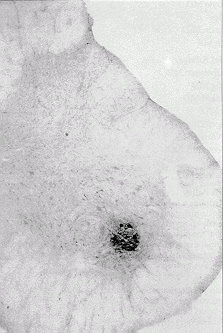
 |
| Retrogradely labelled spinal cord motoneurons to one leg muscle |
This group of investigators has begun to focus basic science and clinical research efforts on functional systems of the spinal cord which must be understood if key abilities altered by spinal cord injury or disease are to be restored. The overall objective of this research team is to conduct appropriate studies leading to the development of new techniques for treatment of patients with loss of function controlled by spinal cord neuronal systems. Current basic research is concentrated on locomotion, micturition and other systems which directly influence spinal motoneurons, and on factors which influence the potential for regeneration in functional spinal systems.
Clinical projects are designed to test the presence of a central pattern generator for locomotion (see below) in humans with spinal cord injury, and to develop pharmacological interventions of therapeutic benefit for functional systems in spinal cord injured patients. Numerous projects are underway, with funding provided through a Medical Research Council program grant, a grant for international collaboration from the Human Frontiers in Science Program, and a Canadian collaborative effort funded from the Network of Centres of Excellence on Neural Regeneration and Functional Recovery.
In my article (pages 83-85), I will focus briefly on some of the recent progress in the centre's studies on brainstem and spinal cord mechanisms for initiation of locomotion, and on neural control of sacral neurons involved in micturition. In accompanying papers, Dr KW Cheng (pages 87-89) provides an update of work in his laboratory on factors which inhibit central nervous system regeneration, and Dr P Nance, Dr B Schmidt and Dr D Fewer provide a description of the use of intrathecal baclofen for the control of spasticity in spinal injured patients (pages 90-91).
L M Jordan, PhD
Spinal Cord Research Centre,
The University of Manitoba and
The Health Sciences Centre